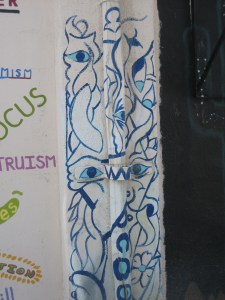We’d left Truth or Consequences later than we’d planned. Then we’d made a couple stops in Las Cruces (breakfast, guitar strings), so the sun was low in the sky as we drove through Tucson. When we turned onto Highway 86 West (also known as Ajo Way), I was disappointed to see a sign declaring we were still
over 100 miles from Ajo. Not only was I tired of driving, but I was afraid driving in the dark would mean we’d miss the two crested saguaros Coyote Sue said were visible from Highway 86.
The Man and I discussed what we should do. Push on and drive into the night, missing the crested saguaros? Find a place to park for the night and see the saguaros in the morning? We decided we wanted to find a place where we could park the van and sleep until first light.
We were soon on Tohono O’odham land. According to Wikipedia,
The Tohono O’odham (/toʊˈhɑːnə ˈɑːtʊm/, or /tɑːˈhoʊnə ˈɑːtəm/)[2] are a Native American people of the Sonoran Desert, residing primarily in the U.S. state of Arizona and the Mexican state of Sonora. Tohono O’odham means “Desert People.” The federally recognized tribe is known as the Tohono O’odham Nation.
The Man kept pointing out places where he thought we could park the van for the night, but I was hesitant to park randomly on the reservation. Although we had nothing to hide from the police, nothing spoils a good night’s sleep like a cop knock in the dark. (If we were ever parked somewhere and a cop knocked in the night, I would simply tell him or her that we were too tired to drive safely, and we’d move on at first light.) Also, I didn’t want to be the white person who thinks she’s entitled to do whatever she wants on native land she knows little about.
I kept driving, and I really was getting to the point of feeling as if I just couldn’t go much father. Then, between mileposts 136 and 137, on the south side of the highway, I saw a picnic area. I pulled in and saw no signs prohibiting overnight parking or even camping. Here it was! This was our spot for the night!
There wasn’t much to the picnic area. There were a few picnic tables there, a shade cover over a few of them. There were no restrooms and not a single trash can. No problem! We only needed to stop for the next six or eight hours.
A fence separated the picnic area from the reservation, but we were too tired to even consider crossing. All I had on my mind was sleep.
When we first lay down, we heard a lot of traffic on the highway, It was a Friday night, and I think people were heading home from their jobs in Tucson, while others were heading to Tucson to party. As the hour grew later, we heard fewer cars on the road, and we slept peacefully.

In the background of this photo, one can see the fence separating the picnic area from the reservation.
The next morning as we stretched and brushed our teeth, The Man noticed an observatory on top of a nearby mountain. Within an hour we passed an entrance road and a sign declaring it the Kitt Peak National Observatory. We didn’t stop, but according to Wikipedia,
The Kitt Peak National Observatory (KPNO) is a United States astronomicalobservatory site located on 2,096 m (6,880 ft) Kitt Peak of the Quinlan Mountains in the Arizona–Sonoran Desert on the Tohono O’odham Nation, 88 kilometers (55 mi) west-southwest of Tucson, Arizona. With 24 optical and two radio telescopes, it is the largest, most diverse gathering of astronomical instruments in the world.[1] The observatory is administered by the National Optical Astronomy Observatory (NOAO).
Roadside America says the Visitor Center is open daily 9-4 (call 520-318-8726 to verify). Admission is free, but one-hour guided tours cost $8.00-$10.00 per person. According to bobebob on 01/25/2015,
The best views of the complex are from the outdoor catwalk around the Mayall telescope, whose 15-ton mirror is housed in a dome 18 stories high.
On Saturday, we spent time with the Diving Miss M, and sometime during our conversation, she mentioned the Arizona Department of Transportation has a 12-foot easement on either side of Highway 86. The land past the easement is part of the reservation. Being left alone at the picnic area made sense. The picnic area is on the easement, which means ADOT maintains it. Surely no ADOT employee was patrolling the area at night to run off sleepy travelers. Tribal police probably aren’t very concerned with what happens at the picnic area since it is technically the ADOT’s jurisdiction. I suppose someone from the Pima County Sherriff’s Department or the Highway Patrol could have questioned us if a complaint had been lodged or if we’d been causing trouble, but we were sleeping, not drinking or yelling or even littering. If an officer of the law saw us parked at the picnic area that night, s/he decided we weren’t worth stopping for. Personally, I was grateful for uninterrupted sleep.
I took all of the photos in this post.













































